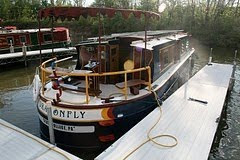 |
| Landmark event: Repairman on deck! |
When the wind or current is strong, we have to use our diesel engine, which is water-cooled, using whatever water we are driving through at the time. Water is sucked in; it flows through a counter-current exchange system--much like your car's radiator--and it's returned to the environment, getting rid of excess engine heat.
Late last week Cap noticed a sharp drop in our coolant reservoir. There was no obvious coolant in the bilges. So apparently the system wasn't leaking. Where was the coolant going?
He ran over the engine plumbing with a finetoothed comb. No clues.
This was a serious situation, because we're crossing some big water, and if a boat engine gets too hot, well, it's like a nuclear power plant. You can have a meltdown. No radioactivity. But total annihilation of your power plant, for sure.
So, after internal resources were exhausted, Cap acted like a prudent head of state. He invited help from an expert. He ALLOWED A REPAIRMAN TO COME ON THE BOAT.
Help came in the form of John Baxter, a compact guy carrying the world's neatest toolbox. John is not only an expert on Yanmar engines, but also a Brit who, back on his home turf, had worked on narrowboats. Perhaps that exceptional qualification took some sting out of allowing another guy to touch the sacred engine.
In roughly 10 minutes flat, John discovered the problem. Under the stairs at the rear of the boat, you can just barely see a gleaming metal box. It's a cabin heater--effectively, a radiator that heats the boat interior, using waste heat from the boat engine. (Again, works just like your car heater.) That's where the leak was--at the point where the hoses joined this box.
 |
| The view under our backstairs: S (supply) and R (return) hoses for the cabin heater |
And coolant WAS leaking into the bilges, but in a bilge compartment under the floor of the rear stateroom--a compartment you can only check by unscrewing and lifting up the floorboards.
A compartment we rarely check, because it's pretty much always dry.
Total cost for the repair: Less than it cost for a plumber to visit our State College home and determine the lack of hot water was caused by a tripped circuit breaker.
And more happy news for the Captain: Although the humorist Dave Barry predicts a dire outcome for the man who allows a repairman to enter the home IF said repairman successfully completes the repair ("He gets to keep your woman,") I'm still on the boat.
If only Japan's problems could be solved so neatly.





No comments:
Post a Comment